Small-Tiled Clutter Games
Match Buster by Simon Stelling
C64, 2012
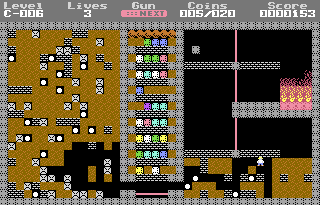
A fascinatingly complex take on Boulder Dash that adds elements from Portal and Match-Three games. It is quite relaxing as there is no time limit and no enemies. This makes it a perfect game to play while listening to music or podcasts.
Later levels might rely a little too much on the portal gun, but there is still so much variation in the level design. I particularly like the levels with fire and water.
My very minor gripe is that I would like larger combinations to be rewarded. Even if you're clever enough to match four or more dice at once, you still only get one coin for each die. But I can see how my wish would mess up the current design.
I was in the middle of Uncharted 4 while I came across this. I didn’t return to Nathan Drake’s adventures until more than a week later, after completing all the levels of this superb puzzle game.
Alphoids by Craig Douglas
Vic 20 unexpanded, Romik, 1983
Ola's Hi-score: 4594
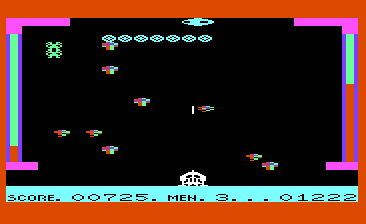
An unusual mix of Centipede and Sega’s Astroblaster. You have two gauges, fuel to the left and temperature to the right. Fuel decreases constantly but faster when you fire. Temperature is only affected by firing but to a much higher degree. You refuel by shooting the alien mother ship that patrols the top in Space Invaders fashion. Temperature decreases when you pause your firing. If you run out of fuel or overheat, you lose a life.
There are two enemies besides the mother ship: Green aliens that only move sideways in columns, and a space snake that moves Centipede-like downwards. The snake splits when it collides with the green aliens. It also splits when you shoot its inner segments. It then leaves a multicolour mushroom in its place
The mushrooms require several shots to get rid of and if you don’t, the screen soon gets crowded and allows the snake to advance much faster towards your ship. It also becomes much more difficult to hit the mother ship, and you will soon run out of fuel. But shooting the mushrooms without overheating is very difficult. This is the main dilemma for the player.
Shoot all snake segments and a new, longer snake appears. To hit the mother ship, you can fire about 20° diagonally to the left and right as well as straight up. This works pretty well and makes the game feel less stiff than most similar contemporary shooters.
All in all, there is a lot here for an unexpanded game. It is also technically above average. The player ship and the mother ship consist of several characters and move smoothly. The snake move char for char (like a real clutter game should); the green aliens move in half char steps. There is even background music (Star Wars), though monophonic.
Atom Smasher by Chris Ratcliffe
Vic 20 unexpanded, Romik, 1983
Ola's Hi-score: 1088
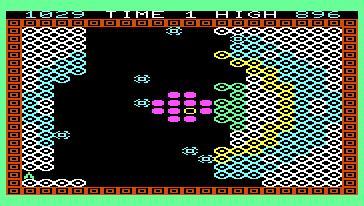
Your goal and motivation can be summarized in four points:
- Shoot the lone proton among the 11 neutrons that make up the nucleus in the centre of the screen (this impedes the growth of debris from meltdown).
- Shoot the debris that grows from the left and right edges of the screen (the game ends when the debris reaches the nucleus or collide with itself in the centre).
- Avoid being hit by electrons (otherwise you lose 1 of your 3 lives).
- Avoid shooting the electrons that orbit the nucleus (they speed up when hit and become even harder to evade).
You might at first think that shooting protons is your main priority. But every proton you hit creates a new electron, and they move - even at their slower base speed - so fast and erratically that they are almost impossible to navigate around.
It’s much safer to hide in the corners and blast away the debris to prevent meltdown and thus score higher. Your score is equal to how long you survive. But you can’t clear debris as fast as it is formed. To reach scores above 650, you therefore need to use both strategies.
Shooting protons only pays off in the beginning since the increased number of electrons will quickly kill off all your lives before the debris reaches the core. Therefore, don’t bother shooting more than 4 protons so you only have 5 electrons to deal with. Then focus on clearing the debris while staying in the corners so that you’re less likely to crash into them. To get well over 1000 points, you need to shoot 5 or 6 protons, but that’s a gamble.
A game round has two distinct phases: a short initial attack phase and a longer final defense. Once you switch to defense mode, there’s hardly any point in trying to shoot more protons. The game would be more fun if there was a smoother transition with undulating offenses and defenses.
The core idea has potential and the interplay between protons, electrons and debris could have made for an explosive action game with fascinating depth from simple rules. But it doesn’t really work as it is.
The controls would also need to be improved. They are not responsive enough and are made even worse by being too complicated.
When you change direction from, for example, down to up, your ship first turns to ↙ then ← then ↖ then ↑ and then finally it moves one char up. It is not tank controls – you push the joystick directly in the direction you want to go. But you have to push it for a long time as your ship cycles through all the transitional frames. This makes char by char movement in a chaotic environment extremely difficult.
There are 10 different skill levels, but strangely enough, they all seem equally hard!
Caterpillar by Jason Benham
Vic 20 3K, Romik, 1983
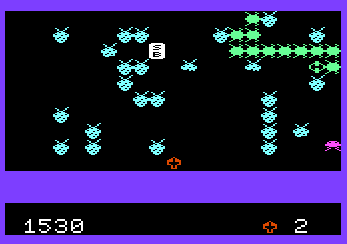
Small-Tiled Clutter Games depend on character-based graphics, which uses a grid of characters, and where each character represents a specific graphical element. This allows for fast rendering, as the computer can operate in text mode and only update the positions and colours of the characters, rather than manipulate individual pixels in a bitmap or a software sprite.
Centipede consists entirely of small dynamic objects, such as the fast-moving player character, the segments of the centipede, and the ever-changing mushrooms. This makes Centipede an ideal arcade game to port to the Vic 20 and other old computers that rely on character-based graphics and lack bitmap mode as well as hardware sprites.
It's thus not surprising to find numerous excellent versions of Centipede for the Vic 20. However, Caterpillar goes against the grain and doesn't make a virtue of necessity. Each object is composed of 2x2 characters, giving it a resemblance more akin to a game for the Philips Videopac G7000 than a typical Vic 20 game. While it does make for an attractive look, it also makes the game board four times as cramped. As a result, there's less that can happen and fewer elements to keep track of during a gaming session. Centipede consequently loses its core quality of being a bustling ecosystem. It's also hard to control, though fast and competently made.
Jason Benham created more Vic 20 games, but for Paramount Software, who promoted him as their whizz-kid. The Pengo clone Chocabloc in particular is worth mentioning.
Galaxia by Mark Conway
Vic 20 unexpanded, Romik 1983
Ola's Hi-score:949 (Autofire is cheating! I reached level 1.8)
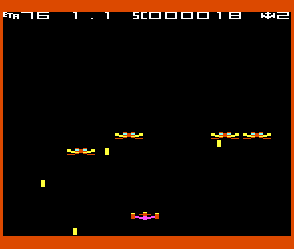
“Standby Human scum!! We show no mercy. Your toughest challenge yet on the 3.5 K Vic 20,” reads the scrolling text on the title screen, and it tells the truth. This ridiculously fast game is not a Galaxian clone, but rather a clone of Imagine’s infamously difficult Arcadia, just even faster and harder.
Just like Arcadia, it mixes single-colour and multi-colour graphics. Some of the chunky multi-colour enemy ships don’t look bad at all. I reached the ninth wave, and new enemy types kept emerging.
The game is too simplistic and murder on your trigger finger, but it introduces an interesting twist to the formula – certain enemies can slip beneath you and attack from behind.
Insector, 1983, Mark Conway, unexp
single screen Defender
Pedes and Mutants, 1983, Pete Bradley, unexp
Downward scrolling chaos shooter. Minter pastiche in sound and visuals

